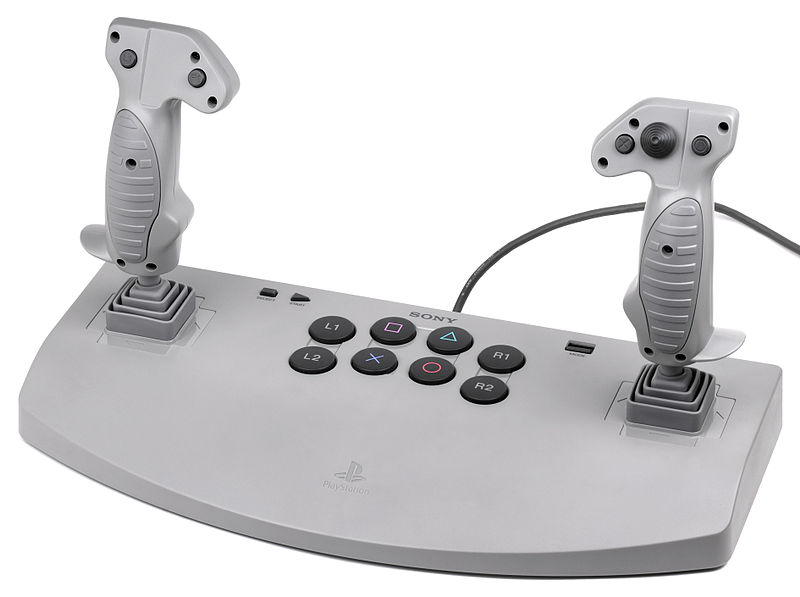It’s no small feat translating a user’s wishes into computer commands. Controlling massive robots in chaotic, fast-paced action of modern console games like Titanfall — and yet even children are able to intuitively tear through AI fodder in their digital mechs. How? Using dual analogue thumbstick controllers. And they’re not just for games.
Any wizened gamer knows that analogue thumbstick controllers — aka thumbsticks — are very different from the control schemes of early consoles. Unlike the original NES, which used electrical contacts for its D-Pad and A/B button inputs, analogue thumbsticks instead rely on potentiometers, which allow a graded input. Where a D-Pad only has two input states, on and off (full speed run or stop), potentiometers allow the user to control the degree of input based on how far the stick is moved from its default center position. This also allows for more than one direction of input be applied simultaneously — an essential advancement as console games have moved from 2D game of the NES and SEGA eras to modern 3D games of the Xbox One and PS4. And those 3d chops are what make them great at controlling the real world as well.
A Brief History of Thumbsticks
Contrary to what your average, shrieking Call of Duty-playing 11 year old might think, thumbsticks trace their roots further back than the advent of gaming. They actually grew out of analogue joystick technology from the early 20th century. Of course, back then joysticks were used in aviation, primarily to help control a plane’s ailerons and elevators. The first confirmed use of these devices can be found on Louis Bleriot’s 1908 Bleriot VIII.
And from this aviation background joysticks quickly found their way into a variety of military aircraft. In fact, the first electronic 2-axis joystick was developed by the Nazis in 1944 to control their early Henschel Hs 293 glide bomb. While it used on-off electrical connections (a la a D-Pad) rather than potentiometers, its design laid the groundwork for modern thumbstick controllers.
Over the next 40 years or so, joystick controllers began to find their way into a number of other industries and applications — from commanding cranes and other construction equipment, to controlling UAVs and remote cameras, even wheelchairs, riding mowers, and military hardware like Raytheon’s Universal Control System.
But it was the explosion of home gaming consoles in the early 1980s that made the analogue stick a ubiquitous computer interface. Specifically, the Atari 5200 was the first, and for a long time only, console to employ a potentiometer-based analogue joystick. Unfortunately, this early design wasn’t self-centering and made controlling onscreen sprites more luck than skill so the design quickly fell out of favour for the digital D-Pad.

Image: Evan-Amos
It would be more than a decade before console makers would take another look at analogue sticks. In 1996, Sony released its PlayStation Analogue Joystick, a hulking table-top controller utilising two, full-size analogue joysticks that provided unmatched performance in a number of PS1 and a few PS2 games such as Descent, MDK, and Mechwarrior 2. This design, though ungainly by today’s standards, was revolutionary at the time and actually served as the design basis for the Playstation 2’s newfangled Dualshock controller redesign which ultimately shrunk the giant joysticks down to thumb-controllable sizes, and offered a pair of sticks instead of a solitary one, paired with a D-Pad or just by its lonesome.
The rise in popularity of 3D gaming graphics has also been instrumental in the adoption of thumbstick controllers, according to Albert Penello, Xbox Director of Product Planning. As he told Gizmodo via email recently:
As 3D graphics advanced and an early style of open-world gameplay grew in popularity, we learned how important analogue was to controlling 3D environments. A D-pad is great for many games (well, just about every game up to the early 2000s!) but was a legacy of 2D consoles. As consoles evolved more 3D, analogue input became more important. Xbox grew-up in the 3D world. For instance the rising popularity of first person shooters — especially Halo, which we prototyped against early in development — meant we built a controller in a time where 3D was hitting its stride and optimised for those types of games.
Halo’s controller layout showed you could play FPS games competitively on a console, and most other shooters have used that same configuration, so it’s endured. Additionally, even platform and action games have become more open-world, which has cemented analogue as the primary input for games today.
The Rise of the Console Controllers
The release of the PS2 Dualshock controller (along with the new PS2 itself) in March of 2000 marks the beginning of the Wiki – Wiki – NowGamer]
Picture: Adrian Hughes
